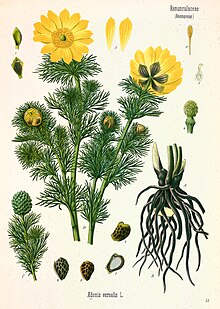Adonis (plant)
| Adonis | |
|---|---|

| |
| Adonis vernalis, spring pheasant's eye | |
| Scientific classification | |
| Kingdom: | Plantae |
| Clade: | Tracheophytes |
| Clade: | Angiosperms |
| Clade: | Eudicots |
| Order: | Ranunculales |
| Family: | Ranunculaceae |
| Subfamily: | Ranunculoideae |
| Tribe: | Adonideae |
| Genus: | Adonis L. |
| Species | |
|
See text | |
Adonis is a genus of about 20–30 species of flowering plants of the crowfoot family, Ranunculaceae, native to Europe and Asia.
The species grow to 10–40 centimetres (3.9–15.7 in) in height, with feathery, finely divided leaves. Their flowers are red, yellow or orange and have 5–30 petals. The Autumn Adonis, pheasant's-eye (A. annua), has flowers with bright red petals.
The generic name Adonis refers to the mythical character Adonis, a lover of the goddess Aphrodite or Venus, and of Persephone, goddess of the underworld. Red flowers of the Adonis genus are said to have grown from the grave of Adonis, after he was slain by a wild boar possessed with unusual viciousness through instigation by the jealous Ares.[1] According to the Metamorphoses of Ovid[2] the anemone, also of the family Ranunculaceae, was created when Venus sprinkled nectar on his blood.
Selected species
- Adonis aestivalis - summer pheasant's-eye
- Adonis aleppica
- Adonis amurensis - Far East Amur adonis
- Adonis annua (syn. A. autumnalis) - pheasant's-eye or blooddrops
- Adonis bobroviana
- Adonis chrysocyathus
- Adonis coerulea
- Adonis cyllenea
- Adonis davidii
- Adonis dentata
- Adonis distorta
- Adonis flammea
- Adonis microcarpa
- Adonis nepalensis
- Adonis palaestina
- Adonis pyrenaica from the Pyrenees, has thick foliage and large golden yellow flowers in early summer.
- Adonis ramosa
- Adonis sibirica
- Adonis sutchuenensis
- Adonis tianschanica
- Adonis vernalis - spring pheasant's-eye
- Adonis volgensis
Cultivation and uses
They are cultivated for use in gardens, and have been introduced to North America. Adonis spp. contain poisonous chemicals similar to those found in many other genera in the Ranunculaceae.
See also
References
- ^ Kerényi, Kàroly (17 January 1980). The Gods of the Greeks. Thames Hudson. ISBN 0500270481.
- ^ Ovid Metamorphoses X 519-741
External links
 Media related to Adonis at Wikimedia Commons
Media related to Adonis at Wikimedia Commons- Flora of China: Adonis
- USDA Plants Profile: Adonis
